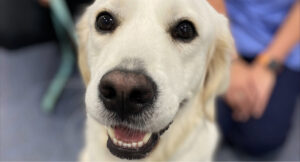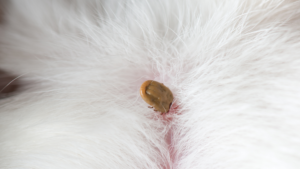What is Intervertebral Disc Disease?
The vertebrae that make up the spine form a cage that protects the sensitive and vital spinal cord that sends messages throughout the body. To allow for mobility, the vertebrae are connected via a series of discs known as intervertebral discs. They also provide padding between each vertebra so that the bones aren’t rubbing against one another with movement which would cause considerable pain! The Discs have a fibrous outer with a jelly-like inner layer. With age, movement, and injuries, these discs degenerate. This causes spinal pain. The Discs can also herniate and press on the spinal cord. Pressure on the spinal cord is not only very painful but can cause paralysis. This may occur suddenly, or more slowly over time depending on the type of herniation that has occurred. Either way, Intervertebral Disc Disease is a condition that requires Veterinary attention. Intervertebral Disc Disease is sometimes also referred to as a bulging, ruptured, herniated, or slipped disc.
Who is affected?
Any breed or species can be affected with IVDD. Obesity, achondroplasia (dogs with long backs and short legs such as Dachshunds and Basset Hounds), and age are all risk factors for this condition.
According to PetSure data in the 2020 calendar year, IVDD was most prevalent in the following breeds:
| Breed | Prevalence |
| Dachshund | 3.32% |
| Miniature Dachshund | 2.02% |
| Tibetan Spaniel | 1.64% |
| French Bulldog | 1.59% |
| Weimaraner | 1.32% |
| Doberman | 1.07% |
| Beagle | 0.91% |
| Bernese Mountain Dog | 0.83% |
| Shih Tzu | 0.82% |
| Pug | 0.70% |
Prevalence = Total number of unique claiming pets / total number of insured pets across 12-month period. Excludes breeds with less than 500 active pet insurance policies.
Signs of IVDD:
Signs of IVDD can depend on whether it has occurred suddenly or over time, as well as where the diseased disc is located along the spine. For sudden IVDD, a yelp may be noted followed by paralysis, involuntary urination, and other signs of pain including shaking, reluctance to move and signs of distress. Some pets may vomit or show other signs which can be related to pain or stress. For slower onset IVDD, there may be a longer history of pain, weakness, decreasing mobility or muscle wastage.
The specific signs, such as which limb, or the number of limbs, affected depends on where along the spinal cord is being compressed. When the diseased disc is in the neck (Cervical IVDD), the pet patient may have mobility issues affecting all four legs, crying or reluctance to move or turn the head, and carry the head cautiously and often held low. It may be difficult for these dogs to lower their head to access their food bowl due to pain.
When the diseased area is in the middle back area (known as the Thoracolumbar area), generally the rear legs are affected, so they may be weak, show signs of incoordination or paralysis.
When the diseased area is in the lower back (known as the Lumbosacral area), the pet patient may have problems with incontinence, normal movement of their tail and mobility issues relating to the rear end, which may include inability or reluctance to navigate stairs or jumping.
If you suspect your dog may have IVDD, do not delay in seeking out Veterinary attention immediately.
Management of IVDD
As previously noted, IVDD is generally very painful, so urgent treatment is recommended to help manage pain. Depending on the severity of the condition and compression of the spine, surgery may be indicated. Severe spinal cord compression may carry a poor prognosis and necessitate euthanasia.
Medical management generally involves lots of rest, pain relief, anti-inflammatory medication which may include steroids and sometimes muscle relaxants. Physiotherapy may be indicated once the pet patient is stable, and pain is under control. The process can take many months and lifelong management is likely to be required once a pet has been diagnosed with IVDD.
Surgery may be recommended for pets with sudden disc compression. The type of surgery will depend on the location of the diseased disc and the type of damage that has occurred. The results of surgery are also varied depending on these factors, as well as the time elapsed between onset of signs and surgery. While some animals can recover completely, some may have ongoing mobility problems, and issues like urinary or faecal incontinence. There is also a considerable recovery period for pets who have had surgery, which can include physiotherapy, manual bladder care, medications, and cage rest.
Some pet parents opt for pet wheelchairs and other devices to help their IVDD affected pets with their mobility.
Your Veterinarian is the best person to discuss the prognosis and best options for your pet should they be diagnosed with IVDD.
How much does it cost to treat?
According to PetSure claims data from the 2020 calendar year, the average cost of a single treatment relating to IVDD was $808. The highest cost for a single treatment was $15,839.
Is it covered by pet insurance?
IVDD may be covered by Comprehensive Accidental Injury and Illness pet insurance policies administered by PetSure (check our brand partners at petsure.gholab.com.au/partners), unless related to a pre-existing condition or exclusion. Please refer to your policy documents including Certificate of Insurance and Product Disclosure Statement (PDS) for more information on whether this condition is covered under your policy.
Disclaimer: Reimbursement for these claims would be subject to limits, such as annual benefit limits or sub-limits, benefit percentage, applicable waiting periods and any applicable excess. Cover is subject to the policy terms and conditions. You should consider the relevant Product Disclosure Statement or policy wording available from the relevant provider.
REFERENCES
- VIN_IVDD_Medical_Or_Surgical 8th June 2021
- VIN_IVDD_Dogs 8th June 2021
Pet insurance can help by covering a portion of the eligible vet bill if the unexpected happens. Because it is difficult to predict the costs of veterinary care, it can help to have measures in place to help prepare for the unexpected. Check out our partner network and explore our policy tools to find a pet insurance policy.
Not all conditions or items are covered by Pet Insurance. Refer to the applicable Product Disclosure Statement for information about coverage and exclusions.



 Fact checked
Fact checked





